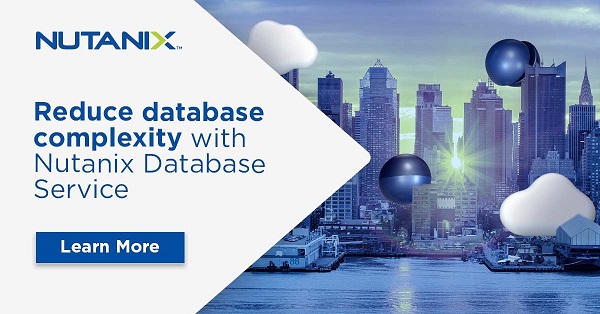Software has moved to the forefront of the business world in the past few decades. Those who create applications bring new services and value to companies. Along the way, many software developers have been crowned as the new kingmakers. But it’s time to look at the wind behind their wings: database administrators, who help manage the data tied to applications.
Every company today is a technology company, said Jeff Kelly, senior product marketing manager for Nutanix’s Database Service. In an interview with The Forecast, he talked about the importance of digital transformation and its role in keeping companies relevant and competitive today. He also talked about the often hidden role of database administrators, which is evolving rapidly as new cloud-powered tools and services help them respond quickly and efficiently to software developer needs.
“Every company, regardless of industry, needs to use software and applications to differentiate itself from the competition,” he said.
“Every company must deliver exceptional digital experiences to customers. And who builds those applications and digital experiences? Developers.”
Digital Transformation Reaches App Development
Some analysts expect to see the number of apps to grow by 50% by 2026, indicating the intense effort and investment pouring into application development.
New technologies, including hybrid multicloud platforms, make it easier for IT teams to facilitate application developers, who are creating apps aimed at bringing more value to the company, according to Lee Caswell, senior vice president of product and solutions marketing at Nutanix.
“These new apps are usually additive and require consistent access to data, whether that data is stored as files, blocks or objects – and whether it lives in the public cloud, the data center or at the edge,” Lee said.
He said modern IT systems powered by hyperconverged infrastructure (HCI) software – such as the Nutanix Cloud Platform – are ready for developing, running and scaling up present and future applications. As businesses update existing or onboard new modern applications, this kind of platform allows IT teams to optimize workloads across their private data center and public clouds.
Even with the broad adoption of the software-as-product mindset, in which developers are responsible not just for building but also operating and updating their code, Kelly said developers rely on other key roles within the broader technology ecosystem to be successful.
“You could argue that none is more important than the database administrator (DBA),” he said. “We need to look back at the evolution of both software development and database management.”
Custom App Development Gives Enterprises a Competitive Edge
Enterprise software development was a much different discipline 25 years ago than it is today. Then, most companies relied on commercial off-the-shelf software (COTS) to run back office operations like finance and HR, and developed little-to-no customer-facing, custom-built applications.
Kelly said it’s important to remember when there were no smartphones and mobile apps back in the 1990s.
“To the extent that companies hired developers to write any custom software, it was usually to build extensions to COTS applications to suit the company’s particular needs and, as the dotcom era dawned, static web pages,” he explained.
Back then, most companies didn’t look to software as a source of innovation.
“I’m willing to bet if you had a time machine and polled a bunch of circa 1997 CEOs about what differentiated their companies from the competition, not too many would say it was their use of software and applications,” he said.
Evolution of Database Administration
The world of databases certainly wasn’t any more exciting. Companies relied on relational databases to store and manage structured data associated with their COTS applications. Most companies standardized on one commercial database or another, as just a handful of database vendors dominated the market back then.
‘To be frank, there really wasn’t that much difference between them,” said Kelly. “It made sense to standardize on one vendor database - say, Oracle or IBM’s DB2 - and get the best volume discount you could.”
Most database administrators chose to specialize in one vendor database or another, which included Oracle DBAs and SQL Server DBAs and DB2 DBAs. Their job was to perform the day-to-day administrative tasks needed to keep the company’s database of choice up and running.
“Important for sure, but not the sexiest of roles,” said Kelly.
His point is that software developers and DBAs played supporting roles in the enterprise and operated in two fairly different worlds. A quarter of a century later, things are much different.
Database Administration and Accelerating App Development
Starting in the early 2000s, engineers at Google, Facebook, and other technology companies revolutionized how software is created and how it runs. Instead of spending months, sometimes years meticulously gathering project requirements before a single line of code was even written, these developers were shipping code on a daily basis.
“‘Move fast and break things,’ was the catchphrase of that time,” Kelly said. “It caused a stir. There was a frenzy of new digital capabilities brought on by new software applications. Before long, companies across different industries wanted in on this action.”
Soon, 100-year-old insurance companies were hiring armies of developers and adopting modern software practices. Industrial conglomerates founded during the Harrison administration opened digital centers of excellence and talked about microservices architecture. Even the U.S. military began running what it called software factories.
“Developers were tasked with building, shipping, and iterating on software, and fast,” said Kelly. “In modern software development, speed and adaptability are the names of the game.”
This is where the databases and DBAs become critical to success.
“Almost every application needs a database to store and manage its associated data,” said Kelly.
He explained that when those applications are staid, back office COTS applications that rarely change, deal with relatively small amounts of structured data, and don’t come anywhere near real-life customers, just about any standard relational database will do.
“When a developer needed a new database, they’d log a ticket, wait two weeks, and presto, they’d get an Oracle 11g,” said Kelly. “But when software is the company’s lifeblood, that approach no longer works.”
Database-as-a-Service for Scaling Database Administration
Since modern applications have become how customers interact with many, if not most companies, today’s web and mobile applications must evolve as they generate massive volumes of multi-structured data.
“Developers need to be able to spin up new database instances quickly and they need access to different types of databases - commercial relational databases for sure, but also commercial and open source document databases, key-value stores, and others - to build new, innovative applications and features that today’s customers expect,” said Kelly.
Twenty years ago, the DBA’s job was to manage the day-to-day administrative tasks required to keep databases up and running. That responsibility remains, but it’s now table stakes.
“Today, the principal responsibility of the DBA, or the DBA team, is to run and operate a database platform that delivers the speed and ease of database deployment, choice of database engine, and variety of database functionality that developers need to build and ship great software,” Kelly said.
“That’s why the DBA and DBA teams are more important today than ever been.”
The job is not an easy one, but it is critical.
“Today, if companies want to operate best-in-class software practices to stay ahead of the competition and delight customers, they need great DBAs,” Kelly continued.
“Just as importantly, companies need to provide DBAs with the tools they need to be successful. This means tools like Database-as-a-Service platforms that allow DBAs to both keep the day-to-day database administrative tasks humming efficiently at scale and deliver high-performance, flexible and easy-to-deploy databases to developers.
Software developers may be recognized as kingmakers, but in today’s data-driven world, it’s important to elevate the importance of DBAs.
Editor’s note: Learn about Nutanix Database Service (NDB), Nutanix’s hybrid multicloud Database-as-a-Service, or take NDB for a Test Drive.
Ken Kaplan is Editor in Chief for The Forecast by Nutanix. Find him on Twitter @kenekaplan.
© 2023 Nutanix, Inc. All rights reserved. For additional legal information, please go here.






